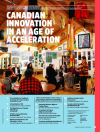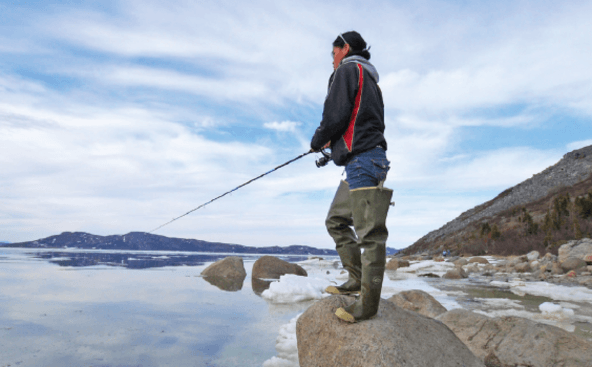Nunatsiavut is a beautiful and unique part of Canada, a self-governing Inuit region within the province of Newfoundland and Labrador that is home to some 2,300 Inuit living along the coast. The communities are small and remote, but very close-knit, dotted between glacial rivers and picturesque mountains. For thousands of years, those living in Nunatsiavut have enjoyed being close to the land, where they have strong family, community, and cultural ties. But in one of the world’s harshest climates, it takes a spirit of qanuqtuurniq—which means “innovation” or “resourcefulness” in Inuktut, the Inuit language— to work together, draw on local knowledge, and overcome the hardships of living in this Arctic region.
Canadian Innovation in an Age of Acceleration

This special supplement highlights innovative social programs, collaborations, and movements underway among Canada’s diverse communities—150 years after the country’s founding—and shares ideas for others involved in similar efforts around the world.
-
The Critical Role of Traditional Knowledge in Social Innovation
-
A New Model for CSR
-
The Digital Future of Canadian Philanthropy
-
A Path to Community Driven Food Innovation
-
Fighting Social Exclusion, One Encounter at a Time
-
Supporting Women’s Rights in Troubled Times
-
An Invitation to Explore Indigenous Innovation
-
Out of the Lab and into the Frontline
-
Crowdsourcing Refugee Resettlement
-
Building a Canadian Social Finance Fund
-
Canada and the Sustainable Development Goals
Food insecurity is among these challenges. Nunatsiavut’s five communities are inaccessible by road, making them highly dependent on deliveries for store-bought foods that must be flown or shipped to the region. The complex logistics and cost of that process significantly raise food prices. And there is no guarantee that food will be delivered at any given time. The risk of food insecurity increased earlier this year due to shipping delays.
With thinning sea ice and changing migration patterns, northern communities also are deeply feeling the effects of climate change, which exacerbates food challenges even for the most skilled hunters. Add to this the sharp decline in the George River caribou herd, which resulted in a recent ban on hunting caribou—a staple of the Labrador Inuit diet—and a crisis begins to emerge. In May of this year, the Nunatsiavut government released statistics from its “Household Food Security Survey” that indicated that 61 percent of households in the region are food insecure. In one community, the prevalence of household food insecurity exceeded 80 percent.
Innovations Drawing on Old and New
Today, community after community is meeting these issues with social innovation that draws on the old and the new, in efforts to give more people access to healthy, nutritious food. Nunatsiavut is turning to traditional Inuit ways of sharing and providing, as well as the values of qanuqtuurniq, to combat high food prices, food insecurity, and the effects of climate change.
One example is the introduction of modern community freezers, set up by the Nunatsiavut government and operated and supplied by the communities themselves. The use of these freezers marks the resurgence of an idea that dates back to a time when Inuit were semi-nomadic. Hunters would collect food and bring it back to store in underground, permafrost freezers accessible by everyone in the community. People would take only the food they needed, leaving the rest for others. Today’s freezers build on this past innovation. Each community decides how to stock its freezer, including what food to purchase or donate, and what provisions (gas, bullets, etc.) to give to hunters who supply food for the freezers. This practice opens up opportunities for trade between communities to help increase food diversity and also creates the conditions for food sovereignty.
 A woman fishes in the Nunatsiavut community of Nain, in Newfoundland and Labrador. (Photography by Kristen McTavish)
A woman fishes in the Nunatsiavut community of Nain, in Newfoundland and Labrador. (Photography by Kristen McTavish)
Inventive initiatives are also under way to improve access to good food while protecting the region’s biodiversity and animal populations. As noted earlier, the recent hunting ban on caribou, put in place to curb the animals’ decline, has had a significant impact on communities that rely on this food source. In response, the Nunatsiavut government’s Department of Lands and Natural Resources has partnered with Parks Canada to allow Labrador Inuit to hunt moose in Gros Morne National Park on the island of Newfoundland, a three-hour flight south from Nain, one of the communities impacted. This solution has helped to replace a primary food staple, and also to reduce the overpopulation of moose, which have been damaging the park’s vegetation.
Mental, Spiritual, and Communal Well-Being
While these kinds of solutions to tackle food insecurity are vital to Nunatsiavut’s vitality, others with a broader focus on physical, mental, spiritual, and communal well-being are having an equal, if not greater, effect. These programs—designed to be holistic, community-based, and culturally relevant—are producing seeding practices that can sustain these communities and carry Inuit knowledge and values through to new generations.
One example of this approach is a program called Going Off, Growing Strong, which connects Inuit youth with skilled hunters. Each participant is matched with a mentor who teaches hunting, fishing, and trapping skills, an experience that helps communities to become more food secure. Young Inuit also learn important cultural traditions, such as building a kamutik (Inuit sled) and constructing smokehouses to prepare the food they catch. The program not only transmits skills across generations and provides additional food to the community but also helps build resilience among youth facing widespread social, environmental, and cultural change.
Nunatsiavut is now developing a food security strategy for the region that builds on these innovations. But what’s most exciting for Canada’s future is the larger shift that’s taking place to instill Inuit values and ways of life into local solutions. With the right kinds of support and investments around initiatives that are holistic, community-driven, and effective, there’s no shortage of potential for others in Canada to build on the wealth of innovation already happening in Nunatsiavut.
Support SSIR’s coverage of cross-sector solutions to global challenges.
Help us further the reach of innovative ideas. Donate today.
Read more stories by Annie Aningmiuq & Tracy Sarazin.

